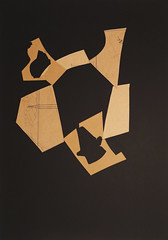I am so pleased to share that my work has been shortlisted for a Saatchi Art Showdown prize, under the category ‘The Body Electric’. The prize drew over 4000 applicant entries, of which Le Petit Echo de la Mode No.5 made the TOP 30 final shortlisted works.
The role of the ‘body’ has played a recurring theme in artworks since Dead Man’s Patterns (2008) an artist’s book inspired by the bespoke suit patterns of a deceased customer, cut by the eminent Savile Row tailors Dege & Skinner. The tailors would ceremoniously shred the patterns of former clients, since there is no value in the parchment without the body. The photographic sequence depicting the making of the garment is charged and ghost-like within the context of the title Dead Man’s Patterns; where the patterns make the absent figure tangible’. Each section of the book suggests different physical states of the ‘man’ with a sense of formal preparation for burial. The physical man is never there; the book’s pages gesture towards intimacy even though they are merely paper.
Subsequently I responded to lingerie tailoring patterns sourced from a London designer (c.1970), by making the series Love Gardens by layering them with coloured paper to create abstract representations of female anatomy referencing the work of Georgia O’Keefe.
To complement this series I used Savile Row shirt collar tailoring patterns and newspaper clippings, with spray paint mounted on inkjet prints to create phallic collages. Suits are the predominant international uniform of men in positions of power. Does Sir dress left or right? This charming tailoring euphemism has a fascinating equivalent in radiology. The John Thomas sign refers to the orientation of a penis in an anteroposterior x-ray. I take the discarded Savile Row menswear tailoring patterns and make their masculinity shockingly explicit. Does the viewer see them as proud or ridiculous? Perhaps, like the x-ray, John Thomas exposes the vulnerability a suit conceals.
In 2013 I was commissioned by Crafts Council, England to exhibit five sculptures at the Saatchi Gallery for Collect. The works were intimate, fragile structures created from quarter-scale military patterns of uniforms from the British Raj (1850-1947). The works epitomized a romantic memory of falling in love with a fictional character – a handsome English officer from the TV mini-series The Far Pavilions (1984). Inspired by the construction of Anthony Caro’s work, the structures were created from the negative space around the patterns to narrate the absent body. The body and its story is no more but my memory and patterns live on.
In my most recent series Le Petit Echo de la Mode the female form is shattered into precise overlapping facets, flattened not as multiple views of a subject but as the object itselfmade from single pattern sheets. These compositions recall the Cubists, who strove to paint pictures that compressed the sensation of all faces of an object simultaneously into one image. Art historian Arnason in History of Modern Art (1988) explains that ‘the cubists like Picasso and Braque broke ancient system’s fixed, unitary, hierarchical focus into democratically multiple perspectives, they created a mixed or composite image, presented as if viewed from many different angles at once’. In this context it is significant to position patterns as relevant 2D flat representations of 3D bodies. Like the Cubists, tailors analyse bodies and produce drafted mathematical patterns that can be viewed as the entirety of the body. Tailoring patterns are artefacts in themselves: they present every facet of a garment, and inevitably the body along with it, on a single sheet of paper. These patterns seduce me, not to cut and detach, but to leave intact and explore the multiple aspects and angles of the body by filling in the planes. In the process this becomes a realization of the Cubist philosophy. The history of these radical original pattern abstractions from fashion magazines (1897–1983) and the history of pattern cutting (1580 onwards) predates the Cubist movement.
My work propose a new interpretation of tailoring patterns as interesting abstracted drawings of the human form which have an inherent aesthetic quality that can be used innovatively to develop a contemporary art practice. Freed from function they are drawings ahead of their time, anthropomorphic in origin and beautifully abstract in isolation.














































